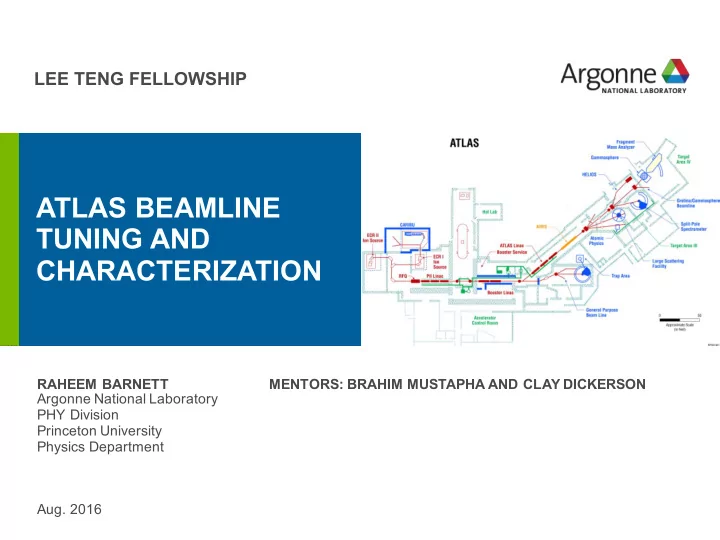

LEE TENG FELLOWSHIP ATLAS BEAMLINE TUNING AND CHARACTERIZATION d r h g f d j h n g n g f m h g m g h m g h j m g h f m f RAHEEM BARNETT MENTORS: BRAHIM MUSTAPHA AND CLAY DICKERSON Argonne National Laboratory PHY Division Princeton University Physics Department Aug. 2016
INTRODUCTION AND MOTIVATION
ATLAS BEAMLINE Overview of beamline sections • Accelerates ions from H to U • m/q ratio of up to 6 • 7-17 MeV/u 3
OVERVIEW March 2016 Runs Purpose: § Test how accelerator handles high intensity beams – 52nA to 5.2uA beams Results: § Found beam transmission was low – 90.3% through P2B when 100% should have been easily achievable Project: § Find where this beam loss and quality degradation are occurring early on to – Prevent quenching of superconducting components – Prevent vacuum degradation from outgassing – Prevent damage to parts not designed to handle the energy deposited by lost particles § Calculate emittance at RFQ from quadrupole scan data taken on March 10 th 4
TRACK BEAMLINE SIMULATIONS Popular Beam Dynamics Simulation Software Used for: • Visualization of the beam envelope along the beamline • Verification of experimental results
PEPPER-POT DETECTOR Finding Beam Initial Conditions 6
OPTIMIZATION OVERVIEW Comparison between the recorded focusing element strengths and values optimized for beam transmission in TRACK Simulation with Recorded Focusing Strengths Optimized Focusing Strengths TRACK Simulated Results From Measured Data
ACCELERATOR BEAMLINE Low Energy Beam Transport Line (LEBT) Simulation with Recorded Focusing Strengths • RFQ Acceptance Matched • Solns. find 100% Transmission Optimized Low Voltage Focusing Strengths • LV Quads 42.4% avg. diff. • HV Quads 17.0% avg. diff. Optimized High Voltage Focusing Strengths HV 𝜻 31.8% • larger than LV 𝜻 8
ACCELERATOR BEAMLINE Positive Ion Injector (PII) Simulation with Recorded Solenoid Strengths Optimized Solenoid Strengths • 20.1% avg. difference between recorded and optimized solenoid strengths • 100% Transmission 9
ACCELERATOR BEAMLINE PII to Booster Line (P2B) Simulation with Recorded Quadrupole Strengths Optimized Quadrupole Focusing Strengths • Beam envelope converges as intended after quad doublet • 13.6% avg. diff. from optimized values 10
QUADRUPOLE SCAN TECHNIQUE Practical for any location with Sequential Quadrupole(s) and BPM Used for: • Calculation of beam emittance and Twiss parameters
QUADRUPOLE SCAN GEOMETRY PII to Booster Line (P2B) Single-Quad Scan Quad-Doublet Scan 12
QUADRUPOLE SCAN FORMALISM Quick overview of the beam matrix and emittance • Statistical distribution of particles in phase space described by an ellipse • Beam matrix sigma can describe the geometric properties of this ellipse • Emittance = area of the ellipse, found by the square root of the beam matrix 13
QUADRUPOLE SCAN FORMALISM Quick overview of transfer matrices (1) (1)&(2) Transfer matrices for focusing and defocusing quadrupole magnets (2) (3) Focusing strength of a quadrupole magnet (4) Transfer matrix for a drift (3) (4) (5) Complete transfer matrix for quadrupole scan geometry (5) (6) Beam matrix propagated from point s 0 to point s (6) 14
QUADRUPOLE SCAN FORMALISM Quadrupole Scan Calculation (1) Propagation of beam matrix (1) through quad geometry s – BPM location s 0 – Start of first quad (2) (2) First element of resulting beam matrix (3) (3) When 3 or more measurements are taken this becomes a fully constrained system of equations with three (4) unknowns (4) A Moore-Penrose pseudoinverse as a least (5) squares fit can be used to find the matrix elements (5) Emittance calculation 15
QUADRUPOLE SCAN TEST SIMULATION Comparison of symmetric and asymmetric scans about beam waist 16
QUADRUPOLE SCAN DATA ANALYSIS Analysis of March 10 th quadrupole scan data • Inconsistency between TRACK and calculated emittance • Calculated emittance is smaller than at Pepper-pot! Conclusion: • Because three points are not enough to statistically determine a quadratic fit these calculations do not yield accurate results 17
CONCLUSIONS AND FUTURE STUDIES Optimizations: • Run LEBT quadrupoles at lower current to prevent early emittance growth Quadrupole Scan: • Quad scans should be swept over the beam waist and include as many data points as possible for greatest accuracy • Because scanning over a quad doublet the data from each quad could be combined in x and y to minimize the number of data points needed for each
ACKNOWLEDGEMENTS • I want to express huge thanks to my advisors Brahim Mustapha and Clayton Dickerson for their guidance throughout this project. • Special thanks to the Lee Teng Fellowship and Argonne National Laboratory. REFERENCES • Rudolph, J. "Slice Emittance Measurement Techniques." Helmholtz Zentrum Berlin. • Crandall et al, “TRACE 3-D Documentation” Los Alamos National Laboratory. Images: • https://www.phy.anl.gov/airis/layout.html • Nagatomo et al, "Development of a Pepper-pot Emittance Meter for Diagnostics of Low-energy Multiply Charged Heavy Ion Beams Extracted from an ECR Ion Source." Rev. Sci. Inst. 87.2 (2016) 19
THANK YOU FOR LISTENING www.anl.gov
Recommend
More recommend